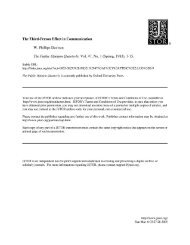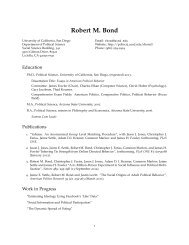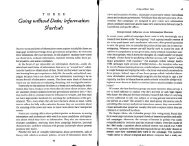Chapter 6 Why Authoritarian Parties? The Regime Party as an ...
Chapter 6 Why Authoritarian Parties? The Regime Party as an ...
Chapter 6 Why Authoritarian Parties? The Regime Party as an ...
Create successful ePaper yourself
Turn your PDF publications into a flip-book with our unique Google optimized e-Paper software.
CHAPTER 6<br />
While both approaches find that authoritari<strong>an</strong> parties are <strong>as</strong>sociated with the survival of<br />
regimes or leaders, they face two limitations: Because Geddes’s cl<strong>as</strong>sification of dictatorships<br />
is not b<strong>as</strong>ed on formal <strong>an</strong>d exclusively party-b<strong>as</strong>ed institutional criteria, inferences b<strong>as</strong>ed on<br />
this data raise questions about whether the longer survival of single-party regimes c<strong>an</strong> be<br />
attributed to the institution of the authoritari<strong>an</strong> party. On the other h<strong>an</strong>d, studies that<br />
examine the <strong>as</strong>sociation between the number of parties <strong>an</strong>d the survival of dictators may be<br />
confounding the effect of parties with the strength of individual leaders.<br />
Consider, first, the approaches b<strong>as</strong>ed on Geddes’s cl<strong>as</strong>sification of dictatorships into per-<br />
sonalist, military, <strong>an</strong>d single-party regimes, <strong>an</strong>d the hybrids of these ideal types. Geddes’s<br />
discussion of the rationale behind her cl<strong>as</strong>sification indicates that she devised it in order to<br />
describe the distinct patterns of leadership origin, political interests, <strong>an</strong>d exercise of power<br />
across dictatorships; it is not a cl<strong>as</strong>sification b<strong>as</strong>ed on formal institutional characteristics. 27<br />
As I have argued in <strong>Chapter</strong> 2, this cl<strong>as</strong>sification design limits our inferences about the<br />
effect of authoritari<strong>an</strong> parties on the survival of dictatorships in two ways. First, because<br />
Geddes’s cl<strong>as</strong>sification is not b<strong>as</strong>ed on formal institutional characteristics, some personalist<br />
<strong>an</strong>d military dictatorships in fact have either multiple political parties (e.g. Brazil during<br />
the military dictatorship from 1965 to 1979) or maintain a single party (e.g. the Cameroon<br />
People’s Democratic Movement under Paul Biya between 1985 <strong>an</strong>d 1990). On the other<br />
h<strong>an</strong>d, some single-party regimes allow for a nontrivial participation of more th<strong>an</strong> one party<br />
(e.g. PAN, <strong>an</strong>d later PRD, in Mexico). In turn, because Geddes’s cl<strong>as</strong>sification is b<strong>as</strong>ed on<br />
a set of criteria that attempt to reflect the functioning of a dictatorship broadly rather th<strong>an</strong><br />
specific institutional characteristics, the distinction between the categories of personalist,<br />
27 See Geddes (1999b, 123-125), Geddes (1999a, 17-22), <strong>an</strong>d Geddes (2003, 69-78).<br />
37











